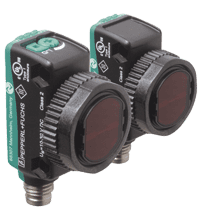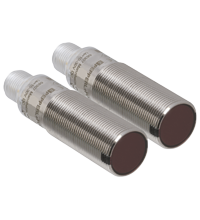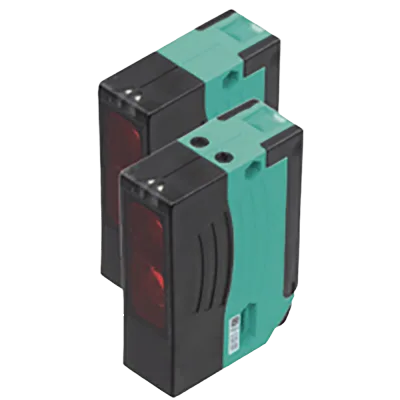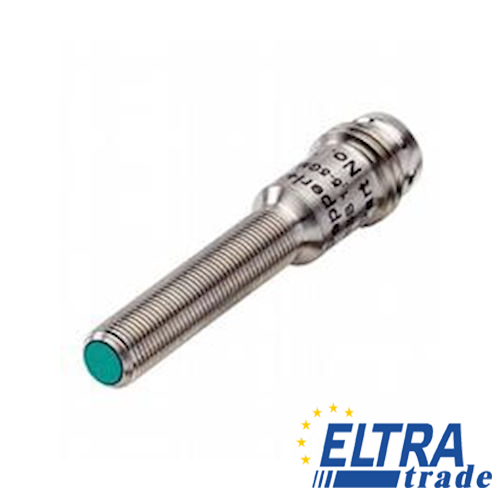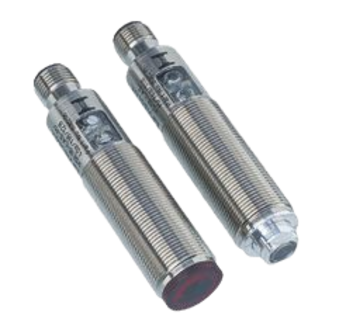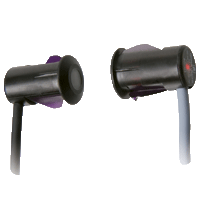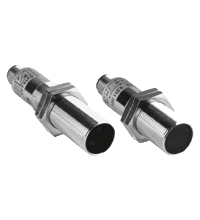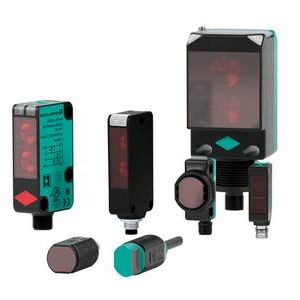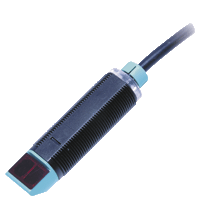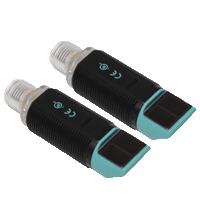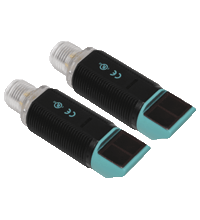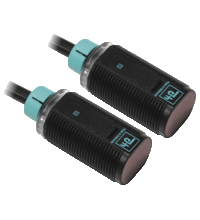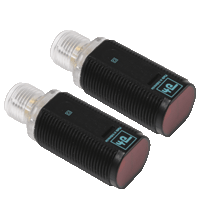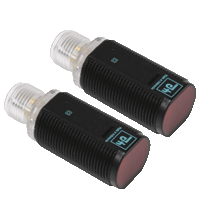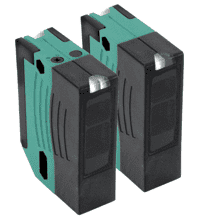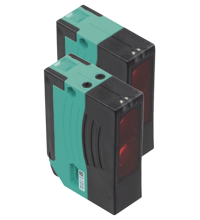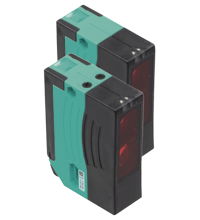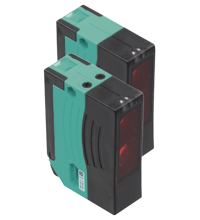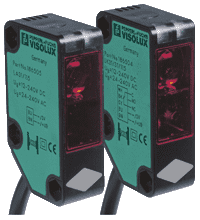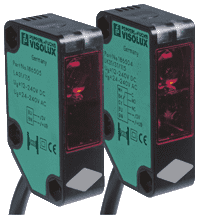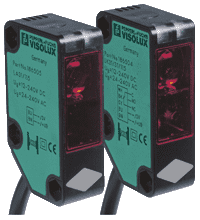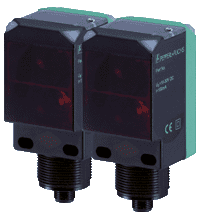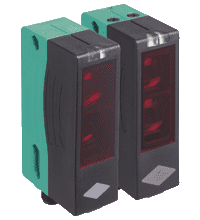Pepperl+Fuchs Thru-Beam Sensors
- Miniature design with versatile mounting options
- IO-link interface for service and process data
- Various frequencies for avoiding mutual interference (cross-talk immunity)
- Extended temperature range
-40В°C ... 60В°C - High degree of protection IP69K
- Housing: M18
- Not sensitive to ambient light
- IP67
- Very high detection rang
LK28 Z F1 31 116
- Type: infrared LED
- Wavelength: 870 nm
- Rise/fall time: < 2 µs
| Maximum DC Voltage | 30V |
| Response time | 0.5 ms |
| Maximum Current | ≤35 mA |
VS18 M LAS 76a 118
- Degree of protection: IP67
- Body material: Stainless steel
- Connector: M12, 4-pin
- Single-beam miniature photoelectric sensor, ideal for installing in frames or contours
- Integrated circuit
- Plug-in style housing for 13 mm hole
- Dark on version
- Laser thru-beam sensor in the M18 housing
- Metal design
- Automatic threshold value adaptation
- Very high switching accuracy
- Light beam diameter < 1.5 mm
- Test input
- Laser thru-beam sensor in the M18 housing
- Metal design
- Automatic threshold value adaptation
- Very high switching accuracy
- Light beam diameter < 1.5 mm
- Test input
- Efficient Line in a short M18 plastic housing for standard applications
- Very high detection range
- 4 LEDs indicator for 360?° visibility
- Sidelookerversion
- Universal usage at different power supplies
- Efficient Line in a short M18 plastic housing for standard applications
- Very high detection range
- 4 LEDs indicator for 360?° visibility
- Sidelookerversion
- DC voltage version
- Efficient Line in a short M18 plastic housing for standard applications
- Very high detection range
- 4 LEDs indicator for 360?° visibility
- Sidelookerversion
- DC voltage version
- Efficient Line in a short M18 plastic housing for standard applications
- Very high detection range
- 4 LEDs indicator for 360?° visibility
- Version with front optical face
- DC voltage version
- Efficient Line in a short M18 plastic housing for standard applications
- Very high detection range
- 4 LEDs indicator for 360?° visibility
- Version with front optical face
- DC voltage version
- Efficient Line in a short M18 plastic housing for standard applications
- Very high detection range
- 4 LEDs indicator for 360?° visibility
- Version with front optical face
- DC voltage version
- Compact fire protection photoelectric sensor for safety devices on fire barriers
- Approval in accordance with VdS Test Report FSA and externally monitored manufacture (?? Symbol)
- Not sensitive to ambient light, even with switched energy saving lamps
- Universal series with highly versatile fields of use
- Resistant against noise: reliable operation under all conditions
- Highly visible LED as alignment aid in receiver optics
- Programmable time function GAN, GAB, IAB as well as GAN-IAB and GAN-GAB as double function
- Laser version for long ranges
- Universal series with highly versatile fields of use
- Resistant against noise: reliable operation under all conditions
- Highly visible LED as alignment aid in receiver optics
- Programmable time function GAN, GAB, IAB as well as GAN-IAB and GAN-GAB as double function
- Version with red light
- Version with relay output
- Robust, compact photoelectric sensor for single-beam gate protection
- Very high detection range
- No measurable emitted interference on all frequencies
- Not sensitive to ambient light, even with energy saving lamps
- Adjustable timer functions
- Version with accessories in scope of delivery
- Cost-optimized series for standard tasks
- Large construction with small housing
- Highly visible LED
- Version for universal voltages
- Relay output
- Wide range of mounting options
- Photoelectric sensor for detecting people, objects and vehicles
- Large construction with small housing
- Not sensitive to ambient light
- Version for universal voltages
- Relay output
- Version with accessories in scope of delivery
- Cost-optimized series for standard tasks
- Large construction with small housing
- Highly visible LED
- Version for universal voltages
- Relay output
- Wide range of mounting options
- Light/dark ON, switchable
- Timer function
- Supplied with mounting accessory
- Degree of protection IP67
- Cost-optimized series for standard tasks in a special design
- Compact design
- Wide range of mounting options thanks to cubic housing design with M30 thread
- 360?° high visibility LEDs
- Programmable ON-delay, OFF-delay, and One-shot timers
- Version for universal voltages
- Relay output
- Universal series with highly versatile fields of use
- Resistant against noise: reliable operation under all conditions
- Highly visible LED as alignment aid in receiver optics
- Emitter with test input
- Version with red light
Pepperl+Fuchs is engaged in the creation of electronics for the automation of industrial processes. In particular, the company manufactures devices based on thru-beam sensing technology. Namely, photoelectric sensors. Today in our article we will consider in more detail one of the types of sensors produced by Pepperl + Fuchs, namely thru-beam sensors.
Components of Thru-Beam Sensors
A photoelectric thru-beam sensor is a device that actuates an electrical switch and emits a signal when a light beam is detected. The sensor consists of a transmitter and a receiver enclosed in separate housings. The transmitter unit emits a light beam directed toward the receiver unit. When an object obstructs the passage of the light beam, the receiver detects the absence of the shaft and triggers the output.
In addition to the main transmitter and receiver, industrial thru-beam sensors have additional components that ensure the reliability of the sensor. This includes reverse polarity protection diodes, surge/overvoltage protection, and LED indicators to indicate the current status of the sensor. Thru-beam sensors find use in applications such as counting objects moving along a conveyor line.
Operation of Thru-Beam Sensors
The thru-beam photoelectric sensor consists of a receiver and a transmitter housed in separate housings and mounted opposite each other. The transmitter sends a light beam (infrared) toward the receiver. The object of control crosses this beam during its movement, causing the optical sensor to operate. The position control accuracy of the barrier sensors is 3-10 mm, depending on the diaphragm used.
Through-beam sensors work very simply. They use the rectilinear propagation property of light. This property describes that electromagnetic waves, such as light, tend to propagate in a straight line into a homogeneous medium.
There are two main components to an end-to-end optical sensor setup:
- the transmitter unit;
- the receiver unit.
Transmitter
The transmitter unit consists of a light source, usually an LED, that emits light in the visible spectrum. This device also contains lenses for focusing and directing the beam. To the naked eye, it would look like a laser beam.
Most transmitters only have power wires. They can be turned on/off by powering on or off. Some sensors may have more than two wires. The extra wires are used to control the beam. Some transmitters can emit a pulsed beam at 500 Hz. These systems are more resistant to external interference since the receiver operates only with a pulsed beam.
Receiver
The receiver unit monitors the beam emitted by the transmitter. Similar to other types of optical sensors, the through-beam sensor has several critical stages in its circuitry.
Applications of Thru-Beam Sensors
Through-beam sensors are versatile devices widely used in industrial automation and control applications. Here are some typical applications for through-beam sensors.
- Object detection. Thru-beam sensors are commonly used to detect the presence or absence of objects in industrial processes. They can be used to track the movement of objects on conveyor belts, determine the position of parts on assembly lines, or detect the presence of things in material handling systems.
- Counting details. Such sensors are well suited for measuring parts or objects as they pass through the sensor beam. This application is widely used in the packaging, manufacturing, and material handling industries to track the production or movement of goods.
- Position definition. Thru-beam sensors can accurately locate objects or components in a system. For example, they can be used to measure the position of moving machine components.
- Automatic control of doors and gates. These devices are used in automatic door and gate control systems. Interruption of the sensor beam by a person or vehicle causes the door or gate to open or close.
- Level measurement. This type of sensor can be used for level measurement, for example, to determine the filling level of liquids or bulk materials in tanks or containers.
- Security systems. These devices play a crucial role in industrial security systems. They monitor hazardous areas and act as safety curtains to prevent personnel from entering dangerous areas while the equipment operates.
- Label detection. Through-beam sensors are used in labeling and packaging applications to detect the presence or location of labels on products or packages.
- Web break detection. In the printing and paper industry, cross-beam sensors can detect web breaks in continuous processes, providing fast responses to prevent waste or damage.
- Robotics and automation. These sensors are used in robotics and automation systems to detect and position objects, allowing robots to interact with their environment accurately.
- Distance measurement. Such devices can be used as distance-measuring systems to calculate the distance between the sensor and the target based on the beam interruption time.
Advantages of Pepperl+Fuchs Thru-Beam Sensors
Thru-beam Pepperl+Fuchs sensors offer several benefits. Let's take a closer look at them.
- Extensive Sensitivity Range. These devices typically have a more excellent sensitivity range than other types of sensors. This makes them suitable for applications where detection over considerable distances is required.
- Precise detection. Through-beam sensors provide highly accurate and reliable detection. Because they rely on a special beam of light, they can detect even small objects with high accuracy.
- Contactless detection. Such sensors work without the need for physical contact with the target object. This non-contact reading minimizes wear on both the sensor and target, resulting in longer sensor life and reduced maintenance costs.
- Insensitivity to environmental conditions. This type of device is less affected by environmental conditions such as dust, dirt, humidity, and temperature changes. The use of light beams ensures stable operation even in harsh industrial environments.
- Fast response time. Thru-beam sensors have a quick response time, allowing them to detect fast-moving objects accurately.
- Universal application. These object detection sensors can be used in various applications, including object detection, part counting, presence/absence detection, conveyor control, material handling, and more.
- Immune to false positives. Because the transmitter and receiver are separate units, the sensor is less susceptible to false alarms caused by reflections or noise in the detection area.
- Easy installation. Separate transmitter and receiver units provide flexible and easy installation.
